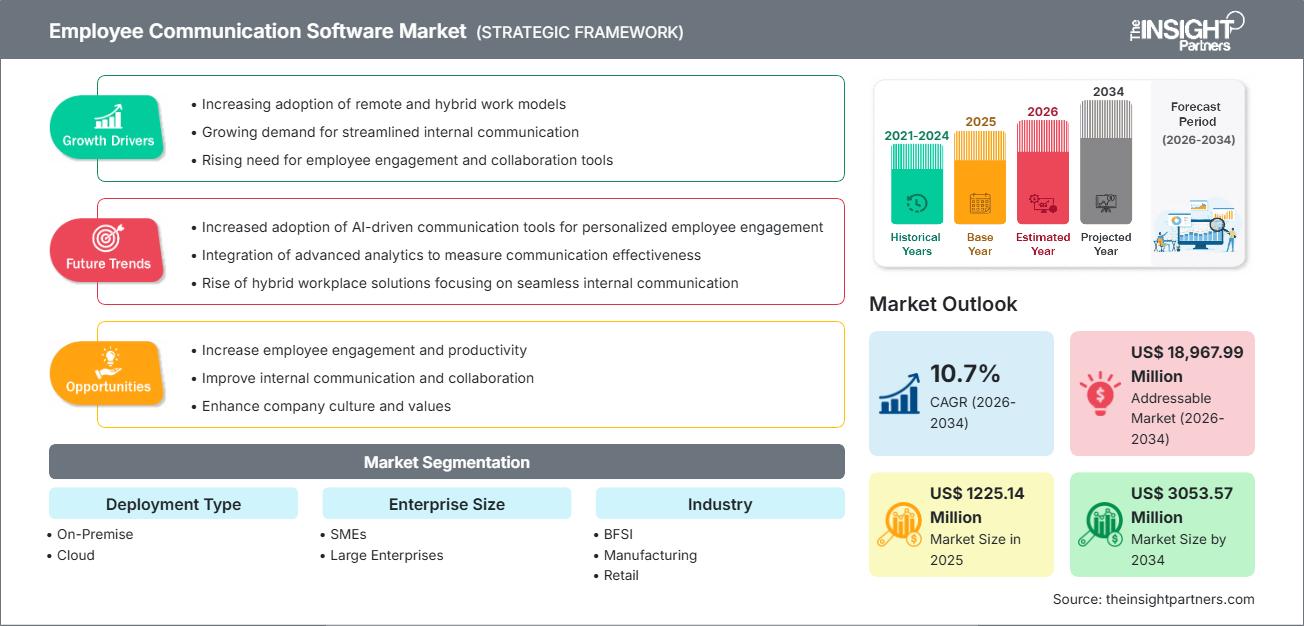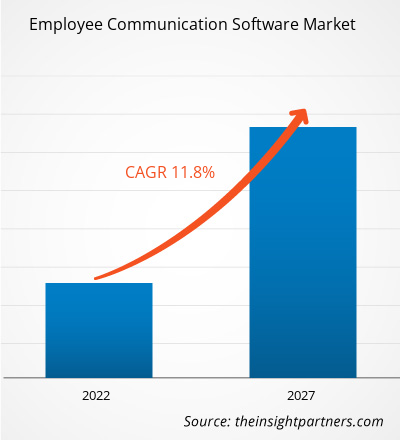预计员工沟通软件市场规模将从2025年的12.2514亿美元增长到2034年的30.5357亿美元。预计在2026-2034年的预测期内,该市场将以10.7%的复合年增长率增长。
员工沟通软件市场分析
远程和混合办公模式的快速转变推动了员工沟通软件市场的增长,因为这增加了对功能强大的内部沟通解决方案的需求。对工作场所数字化转型的投资,旨在提升员工敬业度、协作和实时反馈,将推动相关软件的普及——人工智能、自动化和高级分析技术的集成,用于实现沟通个性化和效果评估。
员工沟通软件市场概览
运用数据和分析来衡量沟通效果并优化内部互动。这些解决方案支持实时消息、公告、反馈、调查和协作。因此,ECS 能够帮助各种规模的企业——从中小企业到大型企业——有效地简化沟通、提升员工参与度并保持分布式团队之间的协同一致。
根据您的需求定制此报告
您可以免费获得任何报告的定制服务,包括本报告的部分内容、国家/地区层面的分析、Excel 数据包,以及面向初创企业和高校的优惠折扣。
员工沟通软件市场:战略洞察

-
获取本报告的主要市场趋势。这份免费样品将包含数据分析,内容涵盖市场趋势、估算和预测等。
员工沟通软件市场驱动因素和机遇
市场驱动因素:
- 远程办公和混合办公模式的日益普及,对内部沟通的顺畅性提出了更高的要求。
- 对员工敬业度和协作工具的需求日益增长。
- 云端通信平台的普及应用日益广泛,以扩展和灵活地支持分布式办公团队。
- 整合人工智能、自动化和高级分析技术,实现个性化沟通并衡量效果。
机会:
- 利用数据和分析来衡量沟通效果并优化内部参与度。
- 使用人工智能驱动的工具(聊天机器人、智能通知)实现日常内部消息传递的自动化。
- 为依赖智能手机进行沟通的非办公人员或现场工作人员开发移动优先平台。
- 通过提供多语言支持、安全的实时通信和反馈渠道,拓展全球企业业务。
员工沟通软件市场细分
按部署类型:
- 本地部署
- 云
按企业规模划分:
- 中小企业
- 大型企业
按行业划分:
- 金融服务业
- 制造业
- 零售
- 卫生保健
- 信息技术与电信
- 其他行业
按地理位置:
- 北美
- 欧洲
- 亚太地区
- 南美洲和中美洲
- 中东和非洲
员工沟通软件市场区域洞察
The Insight Partners 的分析师对预测期内影响员工沟通软件市场的区域趋势和因素进行了详尽的阐述。本节还探讨了北美、欧洲、亚太、中东和非洲以及南美和中美洲等地区的员工沟通软件市场细分和地域分布。
员工沟通软件市场报告范围
| 报告属性 | 细节 |
|---|---|
| 2025年市场规模 | 12.2514亿美元 |
| 到2034年市场规模 | 30.5357亿美元 |
| 全球复合年增长率(2026-2034 年) | 10.7% |
| 史料 | 2021-2024 |
| 预测期 | 2026-2034 |
| 涵盖部分 |
按部署类型
|
| 覆盖地区和国家 |
北美
|
| 市场领导者和主要公司简介 |
|
员工沟通软件市场参与者密度:了解其对业务动态的影响
员工沟通软件市场正快速增长,这主要得益于终端用户需求的不断增长,而终端用户需求的增长又源于消费者偏好的转变、技术的进步以及消费者对产品优势认知的提高。随着需求的增长,企业不断拓展产品和服务,持续创新以满足消费者需求,并把握新兴趋势,这些都进一步推动了市场增长。

- 获取员工沟通软件市场主要参与者概览
员工沟通软件市场份额地域分析
- 北美:历史上一直占据主导地位,这得益于早期采用数字化工作场所、强大的技术基础设施和大型企业。
- 欧洲:由于监管合规、数字化转型和对员工体验的关注,需求不断增长。
- 亚太地区:由于远程办公的兴起、中小企业的增长以及云计算的普及,该地区具有很高的发展潜力。
- 南美洲和中美洲以及中东和非洲:正在兴起,主要发生在投资数字化转型和内部沟通平台的公司中。
员工沟通软件市场参与者密度:了解其对业务动态的影响
ECS市场由专业通信平台供应商、企业软件公司和人力资源工具提供商组成。由于以下原因,竞争日益激烈:
- 对与人力资源系统、协作工具和反馈平台无缝集成的需求。
- 通过人工智能驱动的互动、分析和智能通知功能实现差异化。
- 通过云优先架构实现可扩展性和灵活性。
- 采用安全加密技术,确保内部通信安全合规。
员工沟通软件市场的主要公司包括:
- 养蜂人农业
- 推搡公司
- 波普洛
- Simpplr 公司
- Smarp Oy
- SnapComms公司
- Sociabble公司
- 员工基地
- 员工应用程序
研究过程中分析的其他公司:
- StaffHub解决方案
- Connecteam 公司
- Workvivo
- 哈佩奥
- BlinkApp
- Zoho Connect
- Jive Software(Aurea 旗下公司)
- Foko零售
- Oktopost
员工沟通软件市场新闻及最新动态
- 将人工智能功能(智能通知、聊天机器人)越来越多地集成到员工沟通平台中,以增强员工参与度并减少人工成本。
- 随着企业扩展其远程和混合办公基础设施,越来越多的企业开始采用基于云的部署方式。
- 采用移动优先的通信平台,特别是对于一线或非办公人员而言,可以实现随时随地的实时互动。
员工沟通软件市场报告涵盖范围及成果
The Insight Partners发布的《2027年员工沟通软件市场预测》报告提供了以下信息:
- 全球、区域和国家层面所有关键细分市场的市场规模和预测。
- 详细分析趋势、驱动因素、制约因素和增长机会。
- 对市场进行PEST和SWOT分析。
- 竞争格局,包括市场集中度、热力图分析和主要供应商。
- ECS市场主要参与者的公司简介。
- 历史分析(2 年)、基准年、预测(7 年)及复合年增长率
- PEST和SWOT分析
- 市场规模、价值/数量 - 全球、区域、国家
- 行业和竞争格局
- Excel 数据集
近期报告
客户评价
购买理由
- 明智的决策
- 了解市场动态
- 竞争分析
- 客户洞察
- 市场预测
- 风险规避
- 战略规划
- 投资论证
- 识别新兴市场
- 优化营销策略
- 提升运营效率
- 顺应监管趋势






















 获取免费样品 - 员工沟通软件市场
获取免费样品 - 员工沟通软件市场